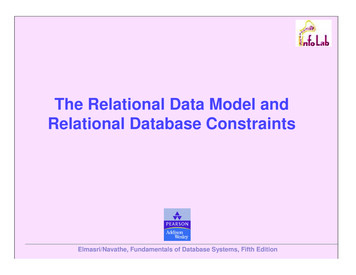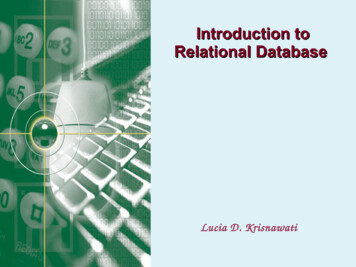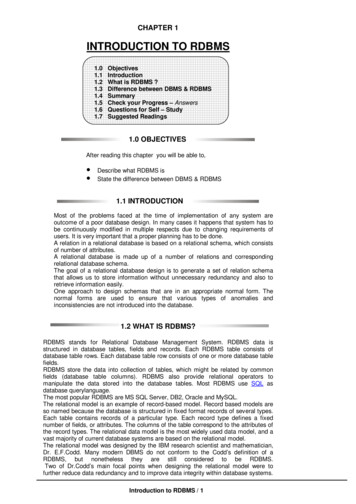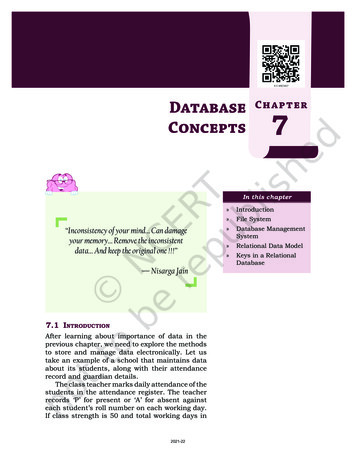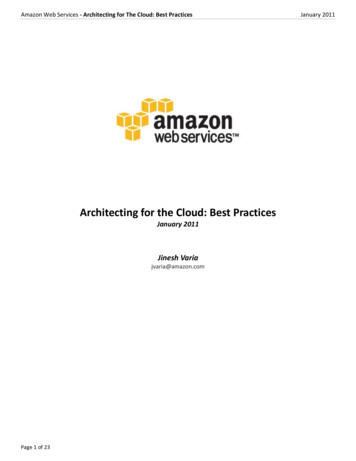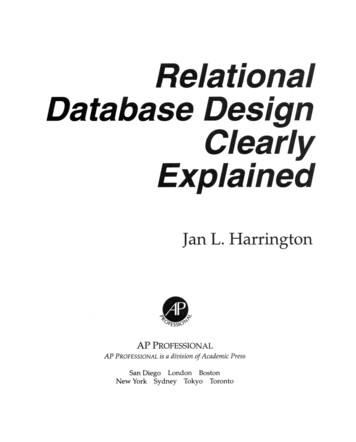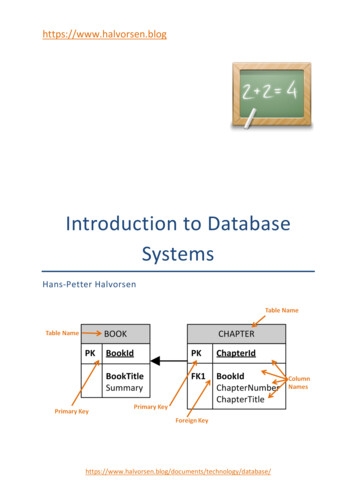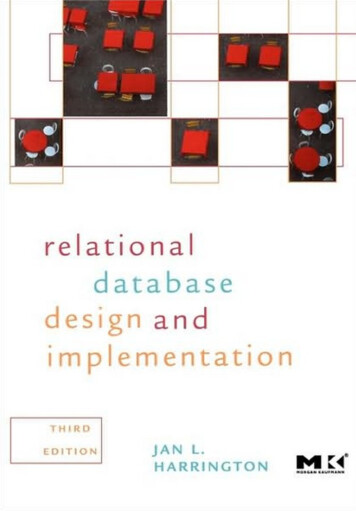
Transcription
Morgan Kaufmann Publishers is an imprint of Elsevier.30 Corporate Drive, Suite 400, Burlington, MA 01803, USAThis book is printed on acid-free paper.Copyright 2009 by Elsevier Inc. All rights reserved.Designations used by companies to distinguish their products are often claimed as trademarks or registeredtrademarks. In all instances in which Morgan Kaufmann Publishers is aware of a claim, the product namesappear in initial capital or all capital letters. All trademarks that appear or are otherwise referred to in thiswork belong to their respective owners. Neither Morgan Kaufmann Publishers nor the authors and othercontributors of this work have any relationship or affiliation with such trademark owners nor do suchtrademark owners confirm, endorse or approve the contents of this work. Readers, however, should contactthe appropriate companies for more information regarding trademarks and any related registrations.No part of this publication may be reproduced, stored in a retrieval system, or transmitted in any form or byany means—electronic, mechanical, photocopying, scanning, or otherwise—without prior written permissionof the publisher.Permissions may be sought directly from Elsevier’s Science & Technology Rights Department in Oxford, UK:phone: ( 44) 1865 843830, fax: ( 44) 1865 853333, E-mail: permissions@elsevier.com. You may alsocomplete your request online via the Elsevier homepage (http://elsevier.com), by selecting“Support & Contact” then “Copyright and Permission” and then “Obtaining Permissions.”Library of Congress Cataloging-in-Publication DataHarrington, Jan L.Relational database design and implementation : clearly explained /Jan L. Harrington.—3rd ed.p. cm.Rev. ed of: Relational database design clearly explained, 1998.Includes bibliographical references and index.ISBN 978-0-12-374730-31. Relational databases. 2. Database design. I. Harrington, Jan L.Relational database design clearly explained. II. Title.QA76.9.D26H38 2009005.75’6—dc222009022380ISBN: 978-0-12-374730-3For information on all Morgan Kaufmann publications,visit our Web site at www.mkp.com orwww.elsevierdirect.comPrinted in the United States of America09 10 11 12 13 5 4 3 2 1Working together to growlibraries in developing countrieswww.elsevier.com www.bookaid.org www.sabre.org
Preface to the Third EditionMy favorite opening line for the database courses I teach is “Probably the most misunderstood term in all of business computing is database, followed closely by the wordrelational.” At that point, some students look a bit smug because they are absolutely,positively sure that they know what a database is and that they also know what is meansfor a database to be “relational.” Unfortunately, the popular press, with the help of somePC software developers, long ago distorted the meaning of both terms, which led manybusinesses to think that designing a database is a task that could be left to any clericalworker who had taken a one-week course on using database software. As you will seethroughout this book, however, nothing could be further from the truth.Note: The media has given us a number of nonsense computer terms such as telephone modem(we’re modulating an analog signal, not a telephone), software program (the two words meanpretty much the same thing), and cable modem and DSL modem (they’re not modems; theydon’t modulate and demodulate analog signals; they are more properly termed codecs that codeand decode digital signals). It’s all in an attempt to make computer jargon easier for people tounderstand, but it has generally had the effect of introducing misunderstandings.This book is intended for anyone who has been given the responsibility for designingor maintaining a relational database. It will teach you how to look at the environmentyour database serves and to tailor the design of the database to the environment. It willalso teach you how to design the database so it provides accurate and consistent data,avoiding the problems that are common to poorly designed databases. In addition, youwill learn about design compromises that you might choose to make in the interest ofdatabase application performance and the consequences of making such choices.If you are a college instructor, you may choose to use this book as a text in an undergraduate database management course. I’ve been doing that for a number of years (alongwith SQL Clearly Explained, this book’s companion volume) and find that students learnfrom it quite well. They appreciate the straightforward language rather than a text thatforces them to struggle with overly academic sentence structures. They also like the manyreal-world examples that appear throughout the book.Changes in the Third EditionThe core of this book—Parts II and III, the bulk of the content of the previous editions—remains mostly unchanged from the second edition. Relational database theory has beenrelatively stable for more than 30 years (with the exception of the addition of sixthnormal form) and requires very little updating from one edition to the next, althoughxv
xvi Preface to the Third Editionit has been seven years since the second edition appeared. The major changes are thediscussions of fifth and sixth normal forms. The first two case studies in Part III havebeen updated; the third case study is new.The chapter on object-relational databases has been removed from this edition, as wellas object-relational examples in the case studies. There are two reasons for this. First,support for objects within a relational environment has largely been provided as a partof the SQL standard rather than as changes to underlying relational database theory.Second, the direction that SQL’s object-relational capabilities have taken since thesecond edition appeared involves a number of features that violate relational designtheory, and presenting them in any depth in this book would be more confusing thanhelpful.By far the biggest change, however, is the addition of the new Parts I and IV. Part Icontains three chapters that provide a context for database design. Database requirements don’t magically appear at the point an organization needs a database, althoughlooking at the previous editions of this book, you might think they did. Chapter 1presents several organizational aspects of database management, including the hardwarearchitectures on which today’s databases run, and a look at service-oriented architecture(SOA), an information systems technique in which databases, like other IT functions,become services provided throughout an organization.Chapter 2 provides an overview of several systems analysis methods to show you howorganizations arrive at database requirements. In Chapter 3 you’ll discover why we careabout good database design. (It really does matter!)Part IV provides an overview of a variety of database implementation issues that youmay need to consider as you design a relational database. The topics include concurrencycontrol (keeping the database consistent while multiple users interact with it at the sametime), data warehousing (understanding issues that may arise when your operationaldatabase data are destined for data mining), data quality (ensuring that data are asaccurate and consistent as possible), and XML (understanding how today’s databasessupport XML).The addition of Parts I and IV also make this book better suited for use as atextbook in a college course. When I used the second edition as a text in my classes,I added supplementary readings to cover that material. It’s nice to have it all in onceplace!The material about older data models that was presented in Chapter 3 in the secondedition has been moved into an appendix. None of the material in the body of the bookdepends on it any longer. You can read it if you are interested in knowing what precededthe relational data model, but you won’t lose anything significant in terms of relationaldatabases if you skip it.
Preface to the Third Edition xviiWhat You Need to KnowWhen the first edition of this book appeared in 1999, you needed only basic computerliteracy to understand just about everything the book discussed. The role of networkingin database architectures has grown so much in the past decade that in addition tocomputer literacy, you now need to understand some basic network hardware and software concepts (e.g., the Internet, interconnection devices such as routers and switches,and servers).Note: It has always been a challenge to decide whether to teach students about systemsanalysis and design before or after database management. Now we worry about wherea networking course should come in the sequence. It’s tough to understand databaseswithout networking, but at the same time, some aspects of networking involvedatabase issues.
AcknowledgmentsAs always, getting this book onto paper involved an entire cast of characters, all of whomdeserve thanks for their efforts. First are the people at Morgan Kaufmann:nnnnnnnRick Adams, my editor of many years. (His official title is Senior AcquisitionsEditor).Heather Scherer, Rick’s capable assistantMarilyn Rash, the project manager. We’ve worked together on a number ofbooks over many years and it’s always a pleasure.Eric DeCicco, the designer of the wonderful cover.The folks who clean up after me: Debbie Prato, copyeditor, and SamanthaMolineaux, proofreader.Ted Laux, the indexer.Greg deZam-O’Hare and Sarah Binns who pulled it all together at the end.A special thanks goes out to my colleague, Dr. Craig Fisher, who is a well-known experton data quality. He provided me with a wealth of resources on that topic, which hethinks should be a part of everyone’s IT education.JLH xix
PartIIntroductionThe first part of this book deals with the organizational environmentin which databases exist. In it you will find discussions about varioushardware and network architectures on which databases operate andan introduction to database management software. You will also learnabout alternative processes for discovering exactly what a databaseneeds to do for an organization.
Chapter1The Database EnvironmentCan you think of a business that doesn’t have a database that’s storedon a computer? Maybe you can’t, but I know of one: a small usedpaperback bookstore. A customer brings in used paperbacks andreceives credit for them based on their condition and, in some cases,the subject matter of the books. That credit can be applied to purchasing books from the store at approximately twice what the store paysto acquire the books. The books are shelved by general type (forexample, mystery, romance, and nonfiction), but otherwise they arenot categorized. The store doesn’t have a precise inventory of what ison its shelves.To keep track of customer credits, the store has a 4 6 card for eachcustomer on which employees write a date and an amount of credit.The credit amount is incremented or decremented, based on a customer’s transactions. The cards themselves are stored in two long steeldrawers that sit on a counter. (The cabinet from which the drawerswere taken is nowhere in evidence.) Sales slips are written by hand,and cash is kept in a drawer. (Credit card transactions are processedby a stand-alone terminal that uses a phone line to dial up the processing bank for card approval.) The business is small, and their systemseems to work, but it certainly is an exception.Although this bookstore doesn’t have a computer or a database, it doeshave data. In fact, like a majority of businesses today, it relies on dataas the foundation of what it does. The bookstore’s operations requirethe customer credit data; it couldn’t function without it.Data form the basis of just about everything an organization that dealswith money does. (It’s possible to operate a business using barteringand not keep any data, but that certainly is a rarity.) Even a Girl Scouttroop selling cookies must store and manipulate data. The troop needsRelational Database Design and ImplementationCopyright 2009 by Morgan Kaufmann. All rights of reproduction in any form reserved.3
4 CHAPTER 1 The Database Environmentto keep track of how many boxes of each type of cookie have beenordered and by whom. They also need to manage data about money:payments received, payments owed, amount kept by the troop,amount sent to the national organization. The data may be kept onpaper, but they still exist, and manipulation of those data is centralto the group’s functioning. In fact, just about the only business thatdoesn’t deal with data is a lemonade stand that gets its supplies fromMom’s kitchen and never has to pay Mom back. The kids take theentire gross income of the lemonade stand without having to worryabout how much is profit.Data have always been part of businesses. Until the mid-twentiethcentury, those data were processed manually. Because they were storedon paper, retrieving data was difficult, especially if the volume of datawas large. In addition, paper documents tended to deteriorate withage. Computers changed that picture significantly, making it possibleto store data in much less space, to retrieve data more easily, and,usually, to store it more permanently.The downside to the change to automated data storage and retrievalwas the need for specialized knowledge on the part of those who setup the computer systems. In addition, it costs more to purchase theequipment needed for electronic data manipulation than it does topurchase some file folders and file cabinets. Nonetheless, the ease ofdata access and manipulation that computing has brought to businesshas outweighed most other considerations.Defining a DatabaseNearly 30 years ago, when I first started working with databases, Iwould begin a college course I was teaching in database managementwith the sentence “There is no term more misunderstood and misusedin all of business computing than database.” Unfortunately, that is stilltrue to some extent, and we can still lay much of the blame on commercial software developers. In this section we’ll explore why that isso and provide a complete definition for a database.Lists and FilesA portion of the data used in a business is represented by lists ofthings. For example, most of us have a contact list that containsnames, addresses, and phone numbers. Businesspeople also commonly work with planners that list appointments. In our daily lives,
Defining a Database 5we have shopping lists of all kinds, as well as “to do” lists. For manyyears, we handled these lists manually, using paper, day planners, anda pen. It made sense to many people to migrate these lists from paperto their PCs.Software that helps us maintain simple lists stores those lists in files,generally one list per physical file. The software that manages the listtypically lets you create a form for data entry, provides a method ofquerying the data based on logical criteria, and lets you design outputformats. List management software can be found not only on desktopand laptop computers but also on our handheld computing devices.Unfortunately, list management software has been marketed underthe name “database” since the advent of PCs. People have thereforecome to think of anything that stores and manipulates data as database software. Nonetheless, a list handled by a manager is not adatabase.Note: For a more in-depth discussion of the preceding issue, see the firstsection of Appendix A.DatabasesThere is a fundamental concept behind all databases: There are thingsin a business environment, about which we need to store data, andthose things are related to one another in a variety of ways. In fact, tobe considered a database, the place where data are stored must containnot only the data but also information about the relationships betweenthose data. We might, for example, need to relate our customers tothe orders they place with us and our inventory items to orders forthose items.The idea behind a database is that the user—either a person workinginteractively or an application program—has no need to worry abouthow data are physically stored on disk. The user phrases data manipulation requests in terms of data relationships. A piece of softwareknown as a database management system (DBMS) then translatesbetween the user’s request for data and the physical data storage.Why, then, don’t the simple “database” software packages (the listmanagers) produce true databases? Because they can’t represent relationships between data, much less use such relationships to retrievedata. The problem is that list management software has been marketed
6 CHAPTER 1 The Database Environmentfor years as “database” software, and many purchasers do not understand exactly what they are purchasing. Making the problem worse isthat a rectangular area of a spreadsheet is also called a “database.” Asyou will see later in this book, a group of cells in a spreadsheet is evenless of a database than a stand-alone list. Because this problem ofterminology remains, confusion about exactly what a databasehappens to be remains as well.Data “Ownership”Who “owns” the data in your organization? Departments? IT? Howmany databases are there? Are there departmental databases, or isthere a centralized, integrated database that serves the entire organization? The answers to these questions can determine the effectivenessof a company’s database management.The idea of data ownership has some important implications. To seethem, we must consider the human side of owning data. People consider exclusive access to information a privilege and are often proudof their access: “I know something you don’t know.” In organizationswhere small databases have cropped up over the years, the data in agiven database are often held in individual departments that are reluctant to share that data with other organizational units.One problem with these small databases is that they may containduplicated data that are inconsistent. A customer might be identifiedas “John J. Smith” in the marketing database but as “John JacobSmith” in the sales database. It also can be technologically difficult toobtain data stored in multiple databases. For example, one databasemay store a customer number as text, while another stores it as aninteger. An application will be unable to match customer numbersbetween the two databases. In addition, attempts to integrate the datainto a single, shared data store may run into resistance from the data“owners,” who are reluctant to give up control of their data.In yet other organizations, data are held by the IT department, whichcarefully doles out access to those data as needed. IT requires supervisor signatures on requests for accounts and limits access to as littledata as possible, often stating requirements for system security. Datausers feel as if they are at the mercy of IT, even though the data areessential to corporate functioning.The important psychological change that needs to occur in either ofthe preceding situations is that data belong to the organization and
Data “Ownership” 7that they must be shared as needed throughout the organizationwithout unnecessary roadblocks to access. This does not mean that anorganization should ignore security concerns but that, where appropriate, data should be shared readily within the organization.Service-Oriented ArchitectureOne way to organize a company’s entire information systems functions is service-oriented architecture (SOA). In an SOA environment, allinformation systems components are viewed as services that are provided to the organization. The services are designed so they interactsmoothly, sharing data easily when needed.An organization must make a commitment to implement SOA.Because services need to be able to integrate smoothly, informationsystems must be designed from the top down. (In contrast, organizations with many departmental databases and applications have grownfrom the bottom up.) In many cases, this may mean replacing mostof an organization’s existing information systems.SOA certainly changes the role of a database in an organization in thatthe database becomes a service provided to the organization. To servethat role, a database must be designed to integrate with a variety ofdepartmental applications. The only way for this to happen is for thestructure of the database to be well documented, usually in some formof data dictionary. For example, if a department needs an applicationprogram that uses a customer’s telephone number, application programmers first consult the data dictionary to find out that a telephonenumber is stored with the area code separate from the rest of thephone number. Every application that accesses the database must usethe same telephone number format. The result is services that caneasily exchange data because all services are using the same dataformats.Shared data also place restrictions on how changes to the data dictionary are handled. Changes to a departmental database affect only thatdepartment’s applications, but changes to a database service may affectmany other services that use the data. An organization must thereforehave procedures in place for notifying all users of data when changesare proposed, giving the users a chance to respond to the proposedchange and deciding whether the proposed change is warranted. Asan example, consider the effect of a change from a five- to nine-digitzip code for a bank. The CFO believes that there will be a significantsavings in postage if the change is implemented. However, the trans-
8 CHAPTER 1 The Database Environmentparent windows in the envelopes used to mail paper account statements are too narrow to show the entire nine-digit zip code. Envelopeswith wider windows are very expensive, so expensive that making thechange will actually cost more than leaving the zip codes at five digits.The CFO was not aware of the cost of the envelopes; the cost wasnoticed by someone in the purchasing department.SOA works best for large organizations. It is expensive to introducebecause typically organizations have accumulated a significant numberof independent programs and data stores that will need to be replaced.Just determining where all the data are stored, who controls the data,which data are stored, and how those data are formatted can be daunting tasks. It is also a psychological change for those employees whoare used to owning and controlling data.Organizations undertake the change to SOA because in the long runit makes information systems easier to modify as corporate needschange. It does not change the process for designing and maintaininga database, but it does change how applications programs and usersinteract with it.Database Software: DBMSsA wide range of DBMS software is available today. Some, such asMicrosoft Access1 (part of the Windows Microsoft Office suite), aredesigned for single users only.2 The largest proportion of today’sDBMSs, however, are multiuser, intended for concurrent use by manyusers. A few of those DBMSs are intended for small organizations,such as FileMaker Pro3 (cross-platform, multiuser) and Helix4 (Macintosh multiuser). Most, however, are intended for enterprise use. Youmay have heard of DB25 or Oracle,6 both of which have versions forsmall businesses but are primarily intended for large installationsusing mainframes. As an alternative to these commercial /default.aspxIt is possible to “share” an Access database with multiple users, but Microsoft neverintended the product to be used in that way. Sharing an Access database is knownto cause regular file corruption. A database administrator working in such an environment once told me that she had to rebuild the file “only once every two or .oracle.com2
Database Software: DBMSs 9many businesses have chosen to use open source products such asMySQL.7For the most part, enterprise-strength DBMSs are large, expensivepieces of software. (The exception to the preceding sentence, of course,is open-source products.) They require significant training and expertise on the part of whoever will be implementing the database. It isnot unusual for a large organization to employ one or more peopleto handle the physical implementation of the database along with ateam (or teams) of people to develop the logical structure of the database. Yet more teams may be responsible for developing applicationprograms that interact with the database and provide an interface forthose who cannot, or should not, interact with the database directly.Regardless of the database product you choose, you should expect tofind the following capabilities: 7A DBMS must provide facilities for creating the structure of thedatabase. Developers must be able to define the logical structure ofthe data to be stored, including the relationships among data.A DBMS must provide some way to enter, modify, and delete data.Small DBMSs typically focus on form-based interfaces; enterpriselevel products begin with a command-line interface. The most commonly used language for interacting with a relational database (thetype we are discussing in this book) is SQL (originally called Structured Query Language), which has been accepted throughout muchof the world as a standard data manipulation language for relationaldatabases.A DBMS must also provide a way to retrieve data. In particular, usersmust be able to formulate queries based on the logical relationshipsamong the data. Smaller products support form-based querying,while enterprise-level products support SQL. A DBMS shouldsupport complex query statements using Boolean algebra (the AND,OR, and NOT operators) and should also be able to perform at leastbasic calculations (for example, computing totals and subtotals) ondata retrieved by a query.Although it is possible to interact with a DBMS either with basicforms (for a smaller product) or at the SQL command line (forSee www.mysql.com. The “community” version of the product is free but does notinclude any technical support; an enterprise version includes technical support andtherefore is fee-based.
10 CHAPTER 1 The Database Environmententerprise-level products), doing so requires some measure of specialized training. A business usually has employees who mustmanipulate data but don’t have the necessary expertise, can’t ordon’t want to gain the necessary expertise, or shouldn’t have directaccess to the database for security reasons. Application developerstherefore create programs that simplify access to the database forsuch users. Most DBMSs designed for business use provide someway to develop such applications. The larger the DBMS, the morelikely it is that application development requires traditional programming skills. Smaller products support graphic tools for“drawing” forms and report layouts. A DBMS should provide methods for restricting access to data. Suchmethods often include creating user names and passwords specificto the database and tying access to data items to the user name.Security provided by the DBMS is in addition to security in placeto protect an organization’s network.Database Hardware ArchitectureBecause databases are almost always designed for concurrent accessby multiple users, database access has always involved some type ofcomputer network. The hardware architecture of these networks hasmatured along with more general computing networks.CentralizedOriginally network architecture was centralized, with all processingdone on a mainframe. Remote users—who were almost always locatedwithin the same building or at least the same office park—workedwith dumb terminals that could accept input and display output buthad no processing power of their own. The terminals were hard-wiredto the mainframe (usually through some type of specialized controller) using coaxial cable, as in Figure 1.1. During the time that theclassic centralized architecture was in wide use, network security alsowas not a major issue. The Internet was not publicly available, theWorld Wide Web did not exist, and security threats were predominantly internal.Centralized database architecture in the sense we have been describingis rarely found today. Instead, those organizations that maintain acentralized database typically have both local and remote users connecting using PCs, LANs, and a WAN of some kind. As you look at
Database Hardware Architecture 11nFigure 1-1 Classic centralized database architecture.Figure 1.2, keep in mind that although the terminals have beenreplaced with PCs, the PCs are not using their own processing powerwhen interacting with the database. All processing is still done on themainframe.From the point of view of an IT department, the centralized architecture has one major advantage: control. All the computing is done onone computer to which only IT has direct access. Software management is easier because all software resides and executes on onemachine. Security efforts can be concentrated on a single point ofvulnerability. In addition, mainframes have the significant processingpower to handle data-intensive operations.
12 CHAPTER 1 The Database EnvironmentnFigure 1-2 A modern centralized database architecture including LAN and WAN connections.One drawback to a centralized database architecture is network performance. Because the terminals (or PCs acting as terminals) do notdo any processing on their own, all processing must be done on themainframe. The database needs to send formatted output to the terminals, which consumes more network bandwidth than wouldsending only the data.A second drawback to centralized architecture is reliability. If thedatabase goes down, the entire organization is prevented from doingany data processing.The mainframes are not gone, but their role has changed as client/server architecture has become popular.
Database Hardware Architecture 13Client/ServerClient/server architecture shares
Relational database design and implementation : clearly explained / Jan L. Harrington.—3rd ed. p. cm. Rev. ed of: Relational database design clearly explained, 1998. Includes bibliographical references and index. ISBN 978-0-12-374730-3 1. Relational databases. 2. Database design. I. Harrington, Jan L
